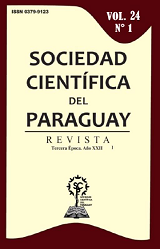Envenomation by Toxic Scorpions in Paraguay: Myth and Reality in the context of the Scorpionism Emergency in Southeast South America
DOI:
https://doi.org/10.32480/rscp.2019-24-1.27-35Keywords:
Scorpions, Tityus, Tityus trivittatus, Tityus confluens, Tityus bahiensis, ParaguayAbstract
Scorpionism is the accident resulting from the envenomation of humans by toxic scorpions. It is considered a health public problem in several tropical and subtropical regions of the world, including the Americas. The extreme venom toxicity of some species belonging to the genus Tityus has prompted the preparation of specific antivenoms in Latin America, which use is considered the only efficacious therapeutic strategy for treating scorpionism. Paraguay is inhabited by three Tityus species of reknown toxicity in neighbouring Brazil and Argentina (T. trivittatus, T. confluens, and T. bahiensis) but their sanitary importance in the country remains unknown. This review updates the list of known scorpion species in Paraguay and their distribution, and also presents data on their toxicity, with the intent to arise interest in the subject considering the recording of severe accidents in children, the possible increase in the number of scorpionism cases in the country as a result of global warming, and the need to identify effective scorpion antivenoms in the country.
Metrics
Downloads
References
2. Borges A., Graham MJ. Phylogenetics of Scorpions of Medical Importance. En: Gompalanokrishnanone, P, Calvete, JJ, editores. Venom Genomics and Proteomics. Dordrecht: Springer Netherlands; 2016. p. 81-103.
3. Chippaux JP, Alagón AC. Envenimations et Empoisonnements par les Animaux Venimeux ou Vénéneux VII: L’Arachnidisme du Nouveau Monde. Med. Trop. 2008;68:215-21.
4. Amitai Y. Scorpions. En: Brent, J, Wallace, KL, Burkhart, K, Phillips, SD, Donovan, J.W., editores. Critical Care Toxicology: Diagnosis and Management of the Critically Poisoned Patient. Maryland Heights: Elsevier Mosby; 2005. p. 1213-20.
5. Chippaux JP. Emerging options for the management of scorpion stings. Drug Des. Dev. Ther. 2012;6:165-73.
6. Harrison PL, Abdel-Rahman MA, Miller K, Strong PN. Antimicrobial peptides from scorpion venoms. Toxicon. 2014;88:115-37.
7. Isbister GK, Bawaskar HS. Scorpion Envenomation. New England J. Med. 2014;371:457-63.
8. Carmo AO, Chatzaki, M, Horta, CC, Magalhães, BF, Oliveira-Mendes, BB, Chávez-Olórtegui, C et al. Evolution of alternative methodologies of scorpion antivenom production. Toxicon. 2015;97:64-74.
9. Brito G, Borges A. A Checklist of the Scorpions of Ecuador (Arachnida: Scorpiones) with notes on the geographical distribution and medical significance of some species. J. Venom. Anim. Tox. incl. Trop. Dis. 2015; 21:23.
10. Ojanguren Affilastro AA. Estudio monográfico de los escorpiones de la República Argentina. Rev. Iber. Aracnol. 2005;11:75?241.
11. De Rood, AR. Comments on Environmental and Sanitary Aspects of the Scorpionism by Tityus trivittatus in Buenos Aires City, Argentina. Toxins (Basel). 2014;6:1434-52.
12. Guerrero D, Kochalka JA. Nuevos registros y revisión de localidades de Buthidae (Arachnida: Scorpiones) para el Paraguay. Bol. Mus. Nac. Hist. Nat. Paraguay. 2015;19(2):62-6.
13. De Roodt A, Lago N, Salomón O, Laskowicz R, Neder de Román L, López R. et al. A new venomous scorpion responsible for severe envenomation in Argentina: Tityus confluens. Toxicon. 2009;53(1):1-8.
14. ABC Color. Reportan casos de picadura de escorpiones en Asunción. 5 de Diciembre de 2002. Disponible en: http://www.abc.com.py/edicion-impresa/locales/reportan-casos-de-picadura-de-escorpiones-en-asuncion-675360.html
15. República Argentina, Ministerio de Salud. Guía de Prevención, Diagnóstico, Tratamiento y Vigilancia Epidemiológica del Envenenamiento por Escorpiones. Buenos Aires, 31 p., 2011.
16. Adilardi RS, Ojanguren Affilastro AA, Martí DA, Mola LM. Cytogenetic analysis on geographically distant parthenogenetic populations of Tityus trivittatus Kraepelin, 1898 (Scorpiones, Buthidae): karyotype, constitutive heterochromatin and rDNA localization. Comp. Cytogen. 2014;8(2):81-92.
17. De Sousa L, Borges A, Vásquez-Suárez A, Op den Camp HJ, Chadee-Burgos RI, Romero-Bellorín M. et al. Differences in venom toxicity and antigenicity between females and males Tityus nororientalis (Buthidae) scorpions. J. Venom Res. 2010; 1:61-70.
18. Needleman RK, Neylan IP, Erickson T. Potential Environmental and Ecological Effects of Global Climate Change on Venomous Terrestrial Species in the Wilderness. Wild. Environ. Med. 2018:226-38.
19. Martinez PA, Andrade MA, Bidau CJ. Potential effects of climate change on the risk of accidents with poisonous species of the genus Tityus (Scorpiones, Buthidae) in Argentina. Spat. Spatio-temporal Epidemiol. 2018;25:67-72.
20. Reckziegel GC, Pinto VL. Scorpionism in Brazil in the years 2000 to 2012. J. Venom. Anim. Tox. incl. Trop. Dis. 2014;20:46.
21. Guerrero D, Kochalka JA, Garcete-Barret BR. Nuevas localidades para Timogenes y Brachistosternus (Scorpiones: Bothriuridae) en Paraguay. Bol. Mus. Nac. Hist. Nat. Paraguay 2017;21(1):27-34.
22. Acosta LE, Ochoa JA. Lista de los escorpiones bolivianos (Chelicerata; Scorpiones), con notas sobre su distribución. Rev. Soc. Entomol. Arg. 2002;61(3-4):15-23.
Downloads
Published
Issue
Section
License
El/los autores autorizan a la Revista de la Sociedad Científica del Paraguay a publicar y difundir el articulo del cual son autores, por los medios que considere apropiado.


















